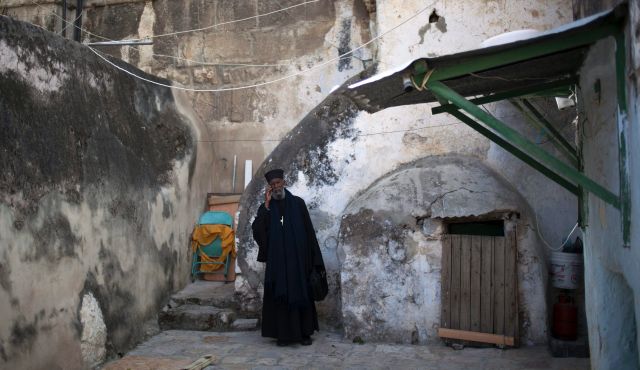 The Ethiopians have no property in the Church of the Holy Sepulcher, only access rights; but they do have a little monastery nearby, known as Deir es-Sultan, that is worth a visit.
The Ethiopians have no property in the Church of the Holy Sepulcher, only access rights; but they do have a little monastery nearby, known as Deir es-Sultan, that is worth a visit.
Jerusalem speaks with many voices, and in a babble of tongues. Nowhere is this more in evidence than the Church of the Holy Sepulcher, in the heart of the Old City’s Christian Quarter. The cavernous medieval structure stands, it is believed, where Jesus was crucified and buried.
It is shared today – unequally and uneasily – by several Christian denominations (none of them Protestant). The Greek Orthodox are the major “shareholders,” followed by the Roman Catholics (“Latins”), Armenian Orthodox, Copts (Egyptian) and the marginalized Syriac Orthodox.
The Ethiopians have no property in the Holy Sepulcher, only access rights; but they have a little monastery, known as Deir es-Sultan, on the roof of a medieval annex. The entrance to the compound is from the Ninth Station of the Cross, up a slightly obscured stairway off Suq Khan e-Zeit, the artery of the Arab market that slices from the Damascus Gate toward the Jewish Quarter. If you can spot a sign on the street leading up to Mike’s Center, a hole-in-the-wall Internet café halfway up the stairway, you’re home free.
Step into the Ethiopian courtyard opposite the Coptic monastery. A weeping willow (rather symbolically) casts some shade across the bare stones, where a defunct water pump, ruined Gothic arches and tiny monks’ cells cower under a skyline of rival crosses. The Ethiopian church has known better days: it lost its lands in a Marxist coup in the 1970s, and the gentle monks sent to the holy city live quietly in scriptural poverty.
In the middle of the courtyard is a small domed structure. Put your ear to one of the barred windows and you’re likely to hear voices from the Chapel of the Cross far below. Once part of the larger Church of the Holy Sepulcher of the Byzantine period, and only accessible from within today’s church, the chapel is also known as the Chapel of St. Helena, for the mother of Constantine the Great, the Roman Emperor. The devout empress visited the Holy Land in 326 CE and initiated the building of the first major sanctuaries, among them the Holy Sepulcher itself and Bethlehem’s Church of the Nativity. The basement chapel is reputed to be the spot where Helena found the True Cross.
Duck through the low stone doorway into a tiny Ethiopian church. The wooden screen at its eastern end is topped by an image of Jesus on the cross. Above his head is a plaque with the translation in Ge’ez (the Ethiopian ecclesiastical language) of “Jesus of Nazareth, King of the Jews,” recorded in the New Testament as the inscription affixed to the cross. Conventional Western art shows the feet of Jesus crossed, but here they appear separated and resting on a block of wood – a more realistic depiction, say some scholars. Beneath the cross, the blood of Jesus drips through a crack in the rock onto a human skull, said to be that of Adam, the first man – a legendary explanation for why the site of the crucifixion is known as Calvary or Golgotha (the place of the skull).
On the long wall of the chapel is a 20th century oil painting depicting the biblical story of the Queen of Sheba visiting King Solomon to “prove his wisdom” with “hard questions.” Her impressive kingdom apparently included Yemen and northern Ethiopia; and she came with a great entourage bearing wondrous gifts. Among Solomon’s counselors in the rendition appear two (startling!) latter-day ultra-Orthodox Jews, complete with the black Hassidic garb so common in the modern city. The artist apparently looked around and identified the most Jewish-looking people for inclusion in his modest masterpiece.
According to Ethiopian tradition, more transpired between the two monarchs during the visit than is recounted in the Bible, and the Queen of Sheba returned home pregnant. The son she bore was Menelik, destined to become the first Ethiopian emperor. The Ethiopian version of events is that the boy was groomed for greatness in his mother’s court, and when he came of age was sent to Israel as heir-apparent to the throne of his biological father.
King Solomon’s legitimate sons did not welcome the interloper, and the king realized there was nothing for it but to send the young man home again. But not empty-handed, surely! At Menelik’s request, says the tradition, he was given an army of the first-born of every family in Israel and the unique, irreplaceable Ark of the Covenant (some versions say “merely” an entourage of aristocrats and priests and a replica of the Ark). According to the Ethiopians, the Ark survives in a carefully guarded sealed crypt beneath a church in Ethiopia.
From the chapel, where a brass plate lies for visitors’ offerings, descend to a lower-level chapel and out the back door to the courtyard of the Holy Sepulcher.
